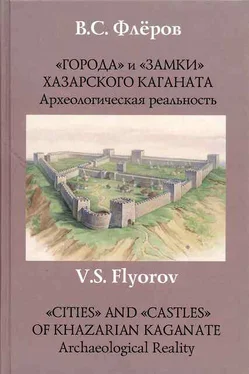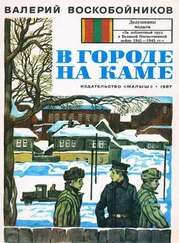Today it is difficult to determine which fortresses of Dagestan were built in the Khazar time after all, for the dating Stratigraphie scale of the ceramics is not worked out for them.
TAMAN AND THE CRIMEA
Were the towns of Tamatarkha, Phanagoria, Bospor — Korchev, Sug-dea (111.26–32) the Khazar ones as S. A. Pletneva believed (1967, c.47–49)? They were founded in the ancient time. Having included these towns into the sphere of their interests for some time the Khazars did not exert any essential influence on the character of the local provincial Byzantine culture. In the cultural layers the artefacts of the Saltovo-Mayatsky culture are represented in small numbers. The Khazars have left no traces in the house-building and fortification of these towns. The role of the Khazar kaganate in the history of the Crimea is exaggerated.
OPUS SPICATUM
In the Russian literature this kind of masonry is called «ёлочка»/а fur-tree that is herring-bone work . S. A. Pletneva and then T. I. Makarova and A. I. Aybabin after her linked its appearance in the towns of the Northern Black Sea area with coming of the Khazars from Dagestan. However, the spreading of the opus spicatum in the Taman and the Crimea only coincided with the Bulgar-Khazar expansion, but was not its result. What is important is the fact that in the vast basin of the Don dwellings with foundations of the opus spicatum type are not found. The connection of the Khazars with the opus spicatum masonry is denied by S. B. Sorochan in well-reasoned way (Сорочан С. Б., 20046).
CAMP AND AUL
In the study of the problem of a «town in the Khazar kaganate» a comparison with the First Bulgar kingdom is expedient. The author has used the works of R. Rashev (Р. Рашев 1982) and other Bulgarian researchers. They divide the defensive structures on the Danube River into two kinds: 1. A camp (лагер), an earthen rampart , mostly rectangular. According to its purpose it is a fortress with a closed rampart along the perimeter. The largest camp was Nikulets (Никулец), 48.3 sq.km in area, with a number of inner fortifications (111.33). The camp was the outside fortification of Pliska (Плиска). 2. Aul (аул), a fortification with the walls of grit stone (a kind of sandstone). According to Rashev: The old Bulgar aul is not only a palace, a court, a complex of court structures of various purposes, but it is first of all a fortified palace . The surrounding of the khan s residence with a fortress wall is the most typical feature of the aul. The first one among the auls was the stony capital Pliska (111.34–36). Preslav (Преслав) (111.38) was a khans aul that developed into a second Bulgar capital. There were no towns proper in the First Bulgar kingdom, which is analogous to the situation in the Khazar kaganate. V. S. Flyorov considers the Bulgar camps and auls to be the analogy of the Khazar fortresses, including also Itil taking into account the peculiarities of the technology of fortress construction in Khazaria.
OLD AND NEW PROBLEMS
About the feudalism in Khazaria. The problem of town is inseparably linked with the appraisal of the degree of «feudalization» of the kaganate. S. A. Pletneva has written about an early feudalism and even developed feudalism, about the feudal land ownership (1982, c.10). But written sources do not confirm this. M. I. Artamonov admitted that «little is known about the forms of social and economic relations in Khazaria» (1962, c.400). It is necessary to admit that historians and archaeologists are unable to give a distinct picture of social relations in the Khazar kaganate. Only some incomplete facts have reached us about the multicolored mosaic of its inner life. The vagueness in the character of the social-economic relations in the Khazar kaganate has full right to exist. The absence of data is not to be replaced by the introduction of well-known cliches, in this case «feudalism», «a feudal town»
Migration or nomadic life. However paradoxical it may be, despite the great number of works mentioning the nomadic life in the Khazar kaganate it is exactly the stage of the nomadic life in it that is studied worst of all Today it is becoming more and more apparent that from the very beginning the kaganate was not a nomadic «steppe state» as it is characterized by S. A. Pletneva. It is more correct to speak about migration and the quick development of a new territory with the subsequent construction of fortifications in the form of ramparts and moats and then fortresses of white stone and bricks. In Eastern Europe the kaganate s population got a new homeland as did the Hungarians for whom we use the formula of «getting a homeland» The pro-Bulgars of Asparukh (Isperikh), too, found a new homeland in the Lower Danube, where they, not without the Slavs’ influence, soon passed to a settled way of life. The question about its stage of the nomadic life and its duration in the kaganate requires a radical revision.
THE KAGANATE ECONOMY
Why has it become necessary to turn to the problem of nomadic life and the nomads camps in a book about fortresses and large settlements? From the position of archaeology they mark the beginning of the Khazar history. The Khazar kaganate emerges as a settled formation of a relatively early state type without the stage of a long nomadic way of life, and by the end of its history it creates a self-sufficient economy and an advanced material culture, but does not after all form high-type settlements — towns. That is its peculiarity: the high development had not necessarily brought about the appearance of towns, although, as it may seem, there were all the preconditions for the appearance of the «khazar towns» The following is its cause. The plenitude of resources, the provision with the products of handicraft and agriculture combined with good natural conditions had brought to an opposite effect: the Khazar kaganate has stopped at the attained level that satisfied the needs of not too stratified society. The issue of a coin of its own did not develop or had declarative purposes; natural exchange prevailed, to which the kagans gafol (polyudye — going round and gathering taxes, products, etc.) corresponded.
Extra stimuli were needed in the sphere of the superstructure, the political ones, to activate money relations and inner commodity circulation, which in its turn would have created conditions for improvements in the handicrafts, which could have been followed by the transformation of some large settlements into towns, and on the whole by the general improvements in the country. The centralization of the state and the suppression of independent chiefs were necessary for this.
ABOUT THE STATEHOOD
The question about Khazar kaganate’s statehood is solved differently by archaeology and history. The archaeological culture of the kaganat can be recognized as that of a «state» since its main manifestations, first of all the ceramics, had spread literally all over the territory of the kaganate. Besides, the Saltovo-Mayatsky culture was outside of being only ethnic.
If we speak about the state of the «Khazar kaganate» and its structure we shall have to consider other categories — the institutions of power, its forms and prerogatives in the centre and in the provinces, the degree of centralization or, on the contrary, the weakness of power. For the Khazar kaganate we do not know the forming of a state that is the supplanting of the customary law by the legal norms fixed in law documents . We have not progressed much in the solving of the question about the essence of the Khazar kaganate s statehood. Regardless of the choice of an answer there can be no doubt about the link between the statehood and urbanization .
Читать дальше
Конец ознакомительного отрывка
Купить книгу











